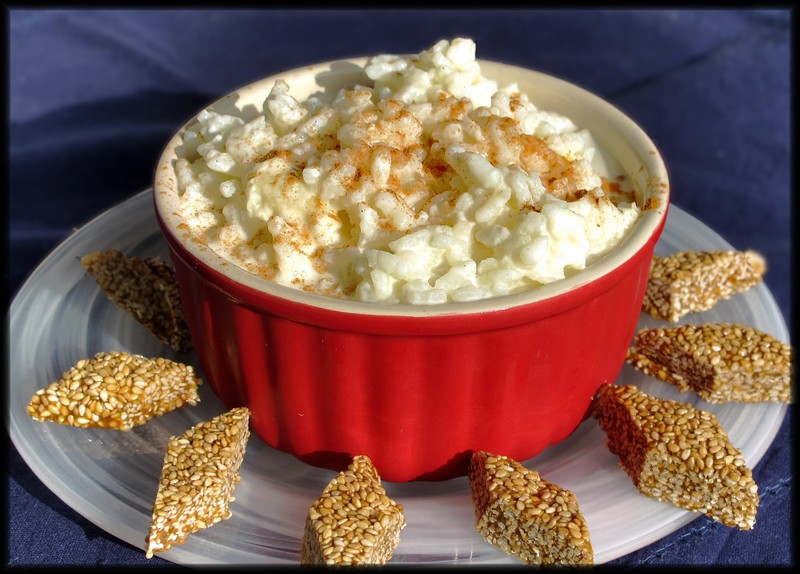When the CHEER Center in Ocean View invited me to hold a cooking demonstration for their members, the director asked me to include their theme for the month and feature an international focus. Since my only equipment would be a single-burner hot plate, I needed to keep things simple. After some research, the answer surprised me - rice pudding.
Food historians believe gruel or porridges made from grains are among the most ancient of cooked foods. They don’t agree on whether India or Persia was where rice pudding originated, but do agree that the dish was first documented in medical texts, rather than in cookbooks.
Throughout the world, for thousands of years rice pudding has been prescribed to treat stomach ailments. Over time, its popularity expanded beyond medical applications, and this highly nutritious, easily digestible dish became popular around the globe. Almost every culture has developed its own version of rice or grain pudding, each with a different spice or flavor profile.
Before adding any variations, there are two basic ways to make rice pudding: combine cooked rice with a milk custard or cook the rice directly in the milk, taking advantage of its thickening properties to help form the custard. At this point, you can add the signature ingredients associated with each country or region.
The Spanish arroz con leche features cinnamon, while Colombian recipes add grated coconut. In Peru you will find cloves, and in Iran the color and flavors of saffron are infused. Cardamom is the spice found in northern India, while Nordic countries and the United States add a liberal splash of vanilla extract.
There is no rule on the choice of rice, but short-grain varieties such as arborio are best for a creamier texture. For a toothier texture and interesting color, consider brown or black rice. Regular long-grain rice, especially the flavorful Jasmine or Basmati may be used as well. Other substitutions include coconut milk, cream, condensed or evaporated milk in place of some or all of the regular milk.
In addition to rice as the central grain in a sweet pudding, you can try Caakiri, a tangy pudding from the Congo. Steamed couscous is combined with yogurt and sour cream that has been seasoned with cardamom. This is designed to be slightly tart, with sweetness coming from the vanilla-flavored yogurt and optional sugar (depending on your taste preferences).
Back to my plans for the demo, I’ll also show the group how to make the traditional Malinese treats shown in the photo. Known as meni-meniyong, these are a combination of toasted sesame seeds and honey toffee.
Make sure to reach for a very sharp knife when ready to cut these crunchy goodies.
Since I won’t have an oven available, I’ll make the Salvadoran quesadilla and bring it along.
Not to be confused with the Mexican appetizer, this is a pound cake made with sweet cheese to round out the selection of international desserts.
If you’d like to sample these sweets at the demo, register with the Ocean View CHEER Center for the class to be held at 10 a.m., Thursday, Sept. 11 (www.cheerde.com/ocean-view).
Rice Pudding
2 C milk
1 cinnamon stick
3 pieces of lemon rind
pinch of salt
1/2 C arborio rice
3 beaten egg yolks
1/3 C sugar
4 T butter
1/4 t nutmeg
1/2 t cinnamon
Combine milk, cinnamon, lemon and salt in a saucepan. Bring to a boil over medium. Once at a boil, remove the cinnamon and lemon with a slotted spoon. Reduce heat to low; whisk in rice and egg yolks. Keep at a simmer for 15 minutes, stirring continuously. Once the rice is tender, add the sugar and butter, mixing well. Pour the mixture into a serving dish and sprinkle with nutmeg and cinnamon. Serve warm or chilled. Yield: 4 servings.
Caakiri
1 C couscous
1/2 C evaporated milk
1 6-oz container vanilla yogurt
1/2 C sour cream
1/4 C sugar (optional)
1/2 t ground cardamom
Prepare couscous according to package directions. While couscous cools, whisk together remaining ingredients in a serving bowl. Fold couscous into milk mixture. Serve warm or chilled. Yield 4 to 6 servings.
Meni-meniyong
1 C honey
4 T butter
1 C toasted sesame seeds
Coat a cookie sheet with nonstick cocking spray; set aside. Combine the honey and butter in a small saucepan. Heat over medium, stirring often, until mixture bubbles and turns rich brown.
Remove from heat, stir in sesame seeds until completely coated. Spread mixture on cookie sheet about 1/4-inch thick.
Cool for about 10 minutes and cut into pieces.
Quesadilla Salvadorena
1 C flour
1 t baking powder
1/4 lb grated queso fresco
1 C sugar
1 eggs
1/2 C milk
1/2 C butter, melted
Preheat oven to 350 F. Coat the inside of a loaf pan with nonstick cooking spray; set aside. Sift the flour and baking powder into a mixing bowl; set aside. Combine cheese, sugar, eggs and milk in a large bowl; beat until smooth. Whisk in the melted butter.
Gradually stir in the flour mixture, mixing into a smooth batter.
Pour batter into prepared pan and bake until a tester comes out clean, about 25 minutes. Cool to room temperature before slicing.

















































